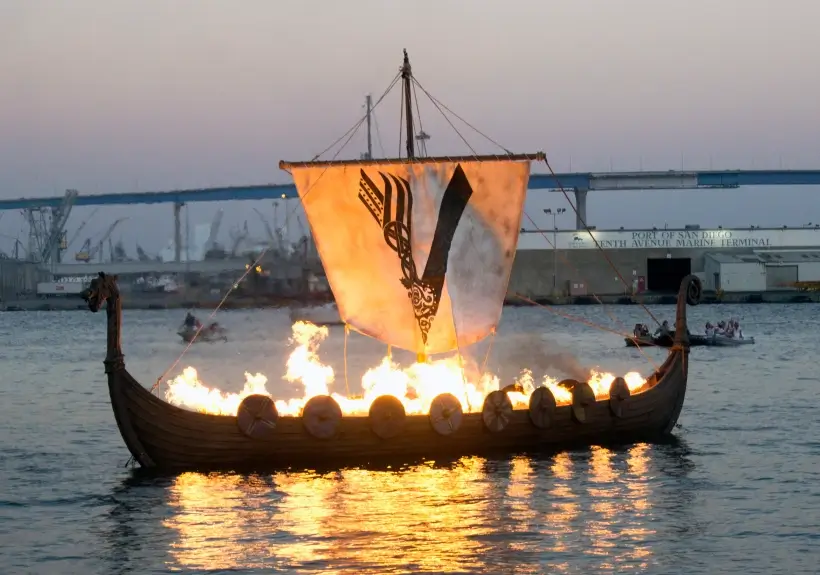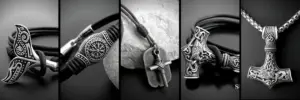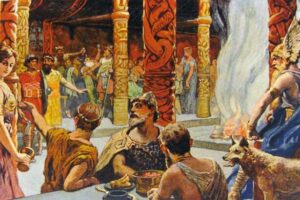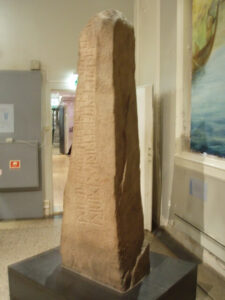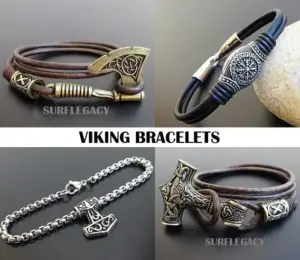The Vikings were fierce and warlike people. They were also people who believed in honoring their dead. One of the ways they did this was through the Viking funeral.
A Viking funeral was a very elaborate and ritualistic affair. It was designed to send the deceased off to the afterlife in style. The body of the deceased was placed on a funeral pyre. The pyre was then set ablaze and the body was allowed to burn.
As the body burned, they would hold a feast. This feast was meant to honor the deceased and to send them off to the afterlife with a full stomach.
After the feast, the ashes of the deceased were gathered up and buried in a grave. The grave was then marked with a stone or a tree.
The Viking funeral was a very important part of their culture. It was a way for them to honor their dead and to send them off to the afterworld in the best way possible.
Key Takeaways:
- Viking funerals involved cremating the deceased on a funeral pyre or ship. The ashes were then buried or scattered.
- Funerals were elaborate rituals designed to honor the dead and help them reach the afterlife.
- Only wealthy, high-status Vikings received ship burials. Poorer people were cremated on simple pyres.
- Grave goods like weapons, tools, and jewels were buried with the deceased. This allowed them to maintain their status in the afterlife.
- Vikings believed the soul was immortal and went through cycles of rebirth until Ragnarök.
- Human sacrifice may have been practiced on rare occasions to appease the gods.
What was a Viking funeral like?
A Viking or Norse funeral is a type of ritual that was practiced by the Norsmen. It was a combination of burial and cremation. The body was placed on a stone ship, which was then set on fire. The ship was usually in the shape of a longboat, as they believed that this would help the deceased reach the afterlife. The ashes were then buried in a mound.
Through archaeological remains, the sagas of Norse literature, and the stories of Ahmad ibn Fadlan, it has been ascertained that the funeral ritual involved the dead being cremated in funeral boats. This funeral practice, however, was only for wealthy chieftains.
Instead, when a poor person died, he was cremated on a small boat built by his friends; when a slave died, the body was left to be devoured by dogs and carrion birds; and when a thief or robber died, his body was hung from a tree and left to be dismembered by wind, rain and wild animals.
In the Ynglingas saga written by the Icelandic poet Snorri Sturluson at one point, we find:
ODIN’S LAWGIVING
“Odin established the same law in his land that had been in force
in Asaland. Thus he established by law that all dead men should
be burned, and their belongings laid with them upon the pile, and
the ashes be cast into the sea or buried in the earth.”
The deceased was placed in a boat or stone ship. The ship could be burned to the ground and reduced to a stake by means of a flashlight or it could be driven into the sea and shot with incendiary arrows.
For them It was important to bury the deceased in the proper manner so that he would be allowed to enter the afterlife, retaining the social standing he had had during his earthly life, and also prevent the soul of the deceased from being forced to wander for eternity.
Funerals that were performed on the ground have enabled archaeologists to study the various Scandinavian traditions of the Viking Age.
The body of the deceased was laid out on the deck of the ship, surrounded by his or her grave goods along with funeral offerings determined according to the status and profession of the deceased. These offerings could also include slave sacrifices. Finally, the whole was covered with stones and earth and a mound was created.
The boat was sprinkled with oil or other incendiary material to facilitate cremation. Cremation was common at the time, and during a funeral, the corpse and grave goods were burned on a funeral pyre.
The temperatures of a cremation far exceeded those of a present-day crematorium, and at the end of the procedure, only a few incinerated fragments of metal, human bones, and some animals remained.
The pyre was built so that the column of smoke was as voluminous as possible: because they believed the smoke helped carry the deceased to the afterlife.
Less affluent people were cremated on funeral pyres. The ashes were then scattered or buried, marking the site with a memorial plaque.
The other known type of funeral is burial: the wealthier Norwegians were buried in burial boats from which the mast, figureheads and other tall parts were removed so that they did not protrude.
Sometimes these boats were specially built, others were actual ships belonging to the deceased that were buried by digging a large grave. Then everything was covered with stones and earth was poured over it, sometimes forming a mound.
How long is a Viking funeral?
Viking funerals were elaborate, multi-day affairs that reflected the wealth and status of the deceased. For common Vikings, the funeral could last 2-3 days, beginning with preparation of the body and culminating in the cremation pyre.
But for nobles and chieftains, ceremonies stretched as long as 4-7 days to accommodate feasting, sacrifices, contests of strength, and the construction of an ornate ship burial.
The longest Viking funeral on record was that of the 10th century King Harald Bluetooth, whose death sparked weeks of drinking, feasting, and ceremonial burial rites across Denmark. Archaeologists believe the time devoted correlated to the power of the deceased – funerals were a display of influence.
But some scholars think Vikings also wanted to prepare loved ones thoroughly for the afterlife through ritual. Either way, Viking funerals stand out for their elaborate length and ceremonial detail.
Grave goods: Haugfe
The grave goods in graves are referred to by the precise term “Haugfé,” an Icelandic word derived from the Norse haugr “mound” and fé “wealth.”
The objects found in 10th-century burials are the most varied: spears, knives, pieces of armor, nails, pins, swords, axes, shields, etc.
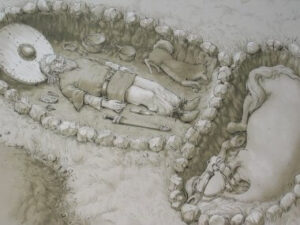
People were frequently buried fully dressed with artifacts, a practice known as haugfé
A free man was usually buried with his weapons and all his riding gear, while a craftsman was accompanied on his final journey by all his tools.
Women could count on the presence of all their jewelry, along with tools for household activities.
Slaves were entitled to a simple hole in the ground, and it was ensured that they were buried in the proper manner so that they could be useful in life after death and most importantly, not come back to haunt their masters.
Viking burials
In Scandinavia, there are large necropolises used by entire communities: Birka in Mälaren, Hedeby in Schleswig, and Lindholm Høje in Ålborg.
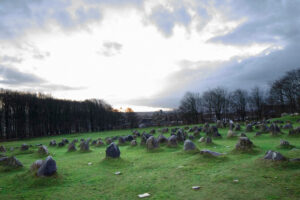
Lindholm Høje burial site
The graves found in Lindholm Høje have a wide variety of shapes and sizes: stone ships; triangular, quadrangular, and circular graves.
Are Viking burials legal?
Yes, burials are legal in some parts of the world. In fact, many people believe that they are more environmentally friendly than traditional burials.
Where Did Vikings Go After Death?
The ancient Scandinavians believed in the afterlife, and they were also very superstitious, which is why funerals had to be minutely celebrated so that the deceased could maintain the status they had achieved in life.
The ship was a symbol of the journey to the afterworld. As a matter of fact, when someone thinks of a Viking funeral, the first image that comes to mind is that of a burning ship.
What happens when a Viking dies?
When a Viking dies, their body is prepared for burial according to their beliefs. The body is washed and dressed in clean clothes. Then, it is placed on a funeral pyre or in a longship along with their possessions.
The pyre or ship is set alight and sent out to sea. After the funeral, a feast is held in honor of the deceased.
If they are burned, their ashes are scattered in the sea or in a field.
Where do they go if they don’t go to Valhalla?
Vikings were fierce warriors who terrified their enemies. But what happened to them when they died? If they didn’t go to Valhalla, where did they go?
The Norse afterworld was a complex and varied belief system. Where one went after death depended on how he died and what kind of life he led.
If a Viking died in battle, they would go to Valhalla, the hall of the slain where they would feast and fight until Ragnarok. But if they didn’t die in battle, their soul could go to Folkvangr, the field of the folk, or Hel, the land of the dead.
If they led a good life and died peacefully, they would go to Folkvangr. But if they led a bad life or committed crimes, they would go to Hel.
Valhalla (1905) by Emil Doepler
Did Vikings fear Death?
Death was also a particularly critical moment surrounded by an aura of fear, even for the brave warriors.
For example, if the deceased were not properly buried, they could return from the afterworld, to visit their relatives, in the form of a ghost.
These “visits” were far from welcome, were thought to be a bad omen, and were believed to be a harbinger of new mourning in the family.
Therefore, in addition to funeral rites, rather extreme precautions were taken to avoid these inauspicious “returns.”
Following the appearance of a specter, the deceased had to die again, so the body was skewered or the head of the deceased was cut off, to
prevent it from finding its way back to the world of the living.
Why were Vikings buried with horses?
Norse culture is full of rich history and traditions. One of these traditions is the burial of Viking warriors with their horses.
There are a few theories as to why Vikings were buried with their horses. One theory is that the horse was seen as a symbol of power and strength.
The horse was also a sign of wealth, as owning a horse was quite expensive. Thus, burying a warrior with his horse showed that he was a powerful and wealthy man.
Another theory is that the horse was seen as a way to help the warrior in the afterlife. The horse would help the warrior travel to the afterworld and make the journey easier.
Finally, some believe that burying a warrior with his horse simply showed respect for the animal. Horses were very important to them and consequently were treated with great care and respect.
Did the Vikings believe in reincarnation?
Yes, they believed in reincarnation. All ancient Germanic peoples believed that the human soul was immortal and that it passed through a cycle of birth, life, and death.
After death, the soul would enter into another body and be born again. This cycle would continue until the final reckoning at Ragnarok, when all souls would be judged and either go to heaven or hell.
There is some evidence that they may have believed in reincarnation specifically. In one Viking funerary poem, a dead warrior says that he has been reborn as a young boy and will fight again in Valhalla.
Another poem describes a woman who has been reincarnated as a swan. And finally, there is a legend of a Viking king who is reborn as an eagle after his death.
Did Vikings sacrifice humans?
The Viking Age was a time of great violence. One of the most brutal aspects of their life was the practice of human sacrifice. It is not clear how often they sacrificed humans, but it was likely a rare event.
Most evidence for human sacrifice comes from written sources, such as sagas and poems. According to them Odin, the king of the gods, required human sacrifices. These sources describe sacrificial rituals in detail, but it is difficult to know how accurate they are.

This engraved depiction on a stone might be interpreted as a sacrifice to Odin. A person appears to be being sacrificed on an altar in the center. Image from Stora Hammars in Lärbro parish, Sweden.
However recent archaeological discoveries demonstrate that human sacrifice was a reality in Viking Age Denmark. Skeletons unearthed from wells at the fortification of Trelleborg and the magnate’s palace at Tiss, both in West Zealand, have changed archaeologists’ minds.
The promontory facing Storebaelt with the well-known circular Viking Age military fortress of Trelleborg erected by Harold Bluetooth in AD 980/981 appears to have been an important ceremonial space, where human and animal skeletons were found, prior to the fortress’s erection
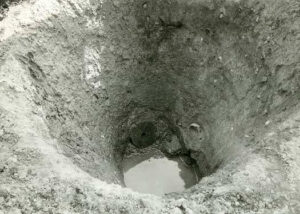
Human skull and quern stone from a well at Trelleborg
Funeral Ale Sjaund
According to studies by Steinsland & Meulengracht Sørensen, and the account of the Arab traveler Ahmad ibn Fadlan, when a chieftain died, about a third of his wealth, was inherited, and another third was used to purchase clothing and goods to use during the ceremony while the rest was used to buy alcohol.
Seven days after the death of a loved one, the sjaund: the funeral ale was celebrated. This also gave the party its name and included a drinking ritual.
The funeral ale was part of Norse culture and served to socially define the event of the passing. Only after this ritual could descendants claim the inheritance.
If the deceased was a widow or the chief, the heir could take over and mark the shift in authority.
In Scandinavia, many of the rune stones deal with inheritance and represent important ownership documents from a time when legal decisions were not yet transferred to paper.
The Tune runestone of Østfold, dated 5th century, declares three daughters of the deceased-as rightful heirs: it is the oldest Scandinavian legal document referring to women’s right to claim their inheritance.
Tune runestone of Østfold
Who has the biggest Viking funeral in history?
Norse chieftains were laid to rest in monumental ship burials. The largest and most magnificent of these was the Oseberg Ship burial.
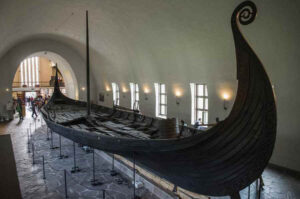
It is one of the most significant Viking archaeological finds in Norway. The ship, which was found in a large mound at the Oseberg farm in 1904, is believed to date back to 834 AD. It is thought to be the final resting place of a wealthy woman, probably a priestess or a queen, and her maidservant.
The ship is nearly 21 meters long and 5 meters wide. It is made of oak and pine, and is decorated with intricate carvings. In addition to the ship, the burial site also contained numerous grave goods, including weapons, tools, jewelry, and pottery.
The Oseberg Ship burial provides a rare glimpse into the lives of the Vikings. It is a remarkable example of their craftsmanship and artistry, as well as their beliefs about death and the afterworld.
Are Viking Funerals Illegal in the USA?
Viking funerals are illegal in the USA because they involve cremation, which is not allowed in the US by law. Vikings believed in an afterlife, and so they would cremate their dead in order to send them off to the next life.
This was done by building a funeral pyre and placing the body on it. Then, the pyre would be set on fire and the body would be cremated.
Burning a loved one’s body is banned in the United States. As a result, Viking-style cremations are not possible. The reason is very simple when a human body is burned, toxic chemicals can be released into the atmosphere, making it unhealthy for humans to breathe.
This is one of the reasons why crematoriums have such strict protocols and rules that must be followed in order to keep workers and adjacent neighbors safe.
The sole outdoor human cremation facility in the United States is located in Crestone, Colorado.
Shop Viking Jewelry
Are passionate about Vikings or Norse Mythology?
Finding the ideal piece of Viking Jewelry can be challenging and time-consuming, especially if you lack inspiration or don’t know where to look.
Surflegacy, has you covered. We have a wide range of Handmade Jewelry in various styles, shapes, colors, and materials, to accentuate your Viking spirit and look. Do not hesitate to visit our selection HERE
Whatever you wear, you’ll find the ideal trendy piece to complement your wardrobe. Our jewelry is designed to be worn every day, no matter where you go or what season is. Are you ready to step up your wardrobe game?

